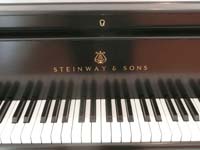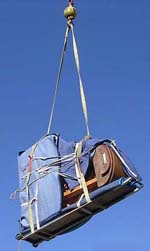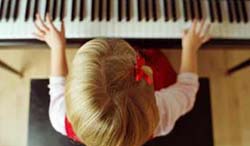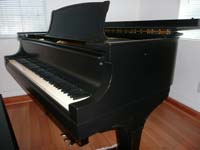This might sound silly but this is actually a very complex question.
When I was growing up, my father Mortin Estrin was a Baldwin artist. When he was selecting new pianos for performances and recordings, we used to go into the Baldwin artist showroom in New York City and he would play all the pianos and choose the one he liked the best. Back then, whenever he would encounter a restored piano he would scoff at them and couldn’t see any value in them. For a large part of my life, I grew up with a similar mindset.
But now things are different for me; I sell restored pianos. So what changed? Well, pretty much everything when it comes to pianos. Back when I was growing up we had Baldwin, Steinway, Mason & Hamlin, Knabe, Sohmer, Chickering, and dozens of more piano brands still producing new pianos in the United States. Today, we only have 3 piano companies left making pianos in the US and the rest are mostly made in huge Asian factories at a fraction of the cost and quality of the handmade pianos of yesterday.
There are still some pianos being made today in America and elsewhere that maintain a very high quality – but unfortunately, they come with a very high price tag. However, the vast majority of new pianos are nowhere up to the standard of the handmade pianos.
At the turn of the 20th century, there were over 1800 companies producing pianos in the United States! Sure, we still remember some of the big names, but with hundreds of companies competing for the top spot, there were plenty of phenomenally high-quality pianos being produced during that time period. Every company had to compete against each other and while everyone was at the peak of production, the quality was at an extremely high level; it had to be. However, the vast majority of pianos ever produced in the US are very old now.
Right before World War II, there were still over 300 piano companies in the United States. They were producing lots of high-quality pianos but even this was a long time ago. Many of these instruments have not stood the test of time – whether they weren’t maintained properly, succumbed to the elements of nature, or just wore out.
Some old pianos have huge potential to be great. The craftsmanship and level of work were outstanding. However, a lot of their potential lies in the life that these pianos have had. How well have they been preserved? And how much work has been done to make them play like a new piano?
In a perfect world where money is no object, you could buy a brand new Hamburg Steinway or Shigeru Kawaii or other top brand and have a wonderful piano. For most people, however, if they are looking for a top tier piano they will most likely consider a vintage instrument that has been meticulously restored.
There is a wide range of tones possible with many of these vintage pianos. Even the old Mason & Hamlins and Steinways have a different quality than the ones being produced today. They have slight differences in the methodology of production. There were also countless, skilled workers from what was a huge industry. Some people think the quality and aging of the woods produces a richer tone like a Stradivarius violin.
From my experience, I have seen quite a bit of magic produced out of the great, vintage pianos. There is a difference in quality and tone that is rare on newer pianos. However, the question of whether or not they are better comes down to the individual pianos. You simply can’t compare the quality of Asian production pianos and handmade pianos. However, this is not to say that every handmade piano is better. Really the bottom line comes down to personal preference. Some people, particularly in rock and pop actually prefer the more strident tones produced by factory pianos today – it is a sound many people have become accustomed to.









